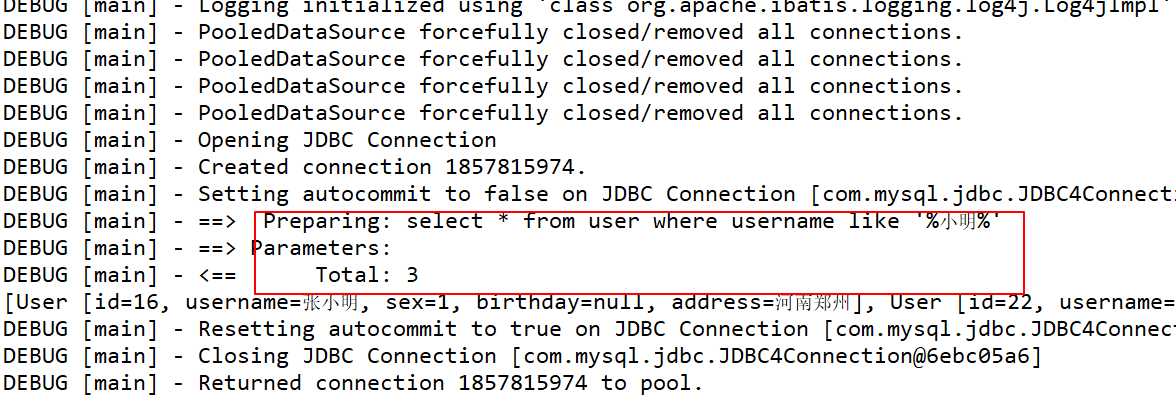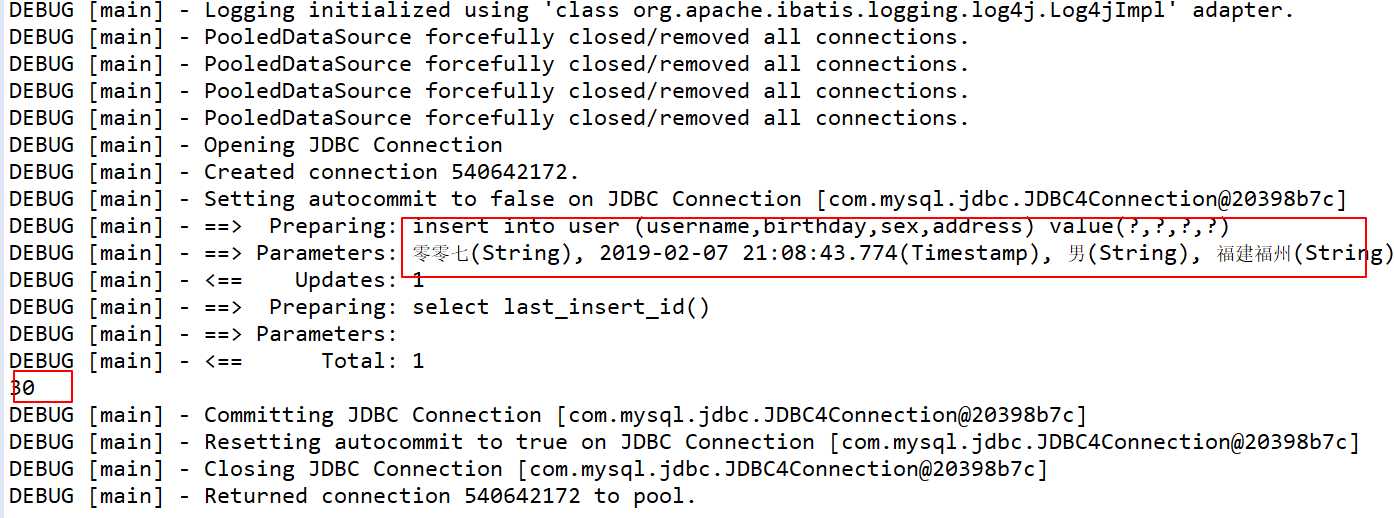mybatis学习记录------2
Posted czsy
tags:
篇首语:本文由小常识网(cha138.com)小编为大家整理,主要介绍了mybatis学习记录------2相关的知识,希望对你有一定的参考价值。
一 单条记录查询
上篇博客的例子便是单条记录查询
二 多条记录查询
1 在映射文件中加入如下sql查询,${}:表示拼接sql串,将接收到的参数不加任何修饰拼接在sql中,${value}:接收输入参数的内容,如果传入类型是简单类型,${}中只能使用value。
<!--根据名称查找记录,可能返回多条记录 resultType:指定就是单条记录所映射的java对象类型 ${}:表示拼接sql串,将接收到的参数不加任何修饰拼接在sql中。 使用${}拼接sql,容易引起sql注入 ${value}:接收输入参数的内容,如果传入类型是简单类型,${}中只能使用value --> <select id="findUserByName" parameterType="String" resultType="pers.czs.mybatis.po.User"> select * from user where username like ‘%${value}%‘ </select>
2 在测试代码中加入如下执行代码,由于查询可能出现多条,因此应该使用list集合存放selectList查询出来的多条记录
@Test public void findUserByNameTest() throws IOException { //Mybatis配置文件 String resource = "SqlMapConfig.xml"; //得到配置文件流 InputStream inputStream = Resources.getResourceAsStream(resource); //创建会话工厂,传入配置文件信息 SqlSessionFactory sqlSessionFactory = new SqlSessionFactoryBuilder().build(inputStream); //通过工厂得到SqlSession会话 SqlSession sqlSession = sqlSessionFactory.openSession(); List<User> list = sqlSession.selectList("test.findUserByName", "小明"); System.out.println(list); sqlSession.close(); }
3 运行结果

三 添加用户(insert)
1 在映射文件中加入相应的代码:其中parameterType:指定输入参数类型是pojo,无返回值,若主键是自增的,则可以不写主键,mysql会自动分配,我这里主键是ID,是自增的,故没写出来
<!--添加用户 parameterType:指定输入参数类型是pojo #{}中指定pojo属性名,接收到pojo对象的属性值,mybatis通过OGNL获取对象属性值 若主键是自增的,则可以不写主键,mysql会自动分配,我这里主键是ID,是自增的,故没写出来 --> <insert id="insertUser" parameterType="pers.czs.mybatis.po.User"> insert into user (username,birthday,sex,address) value(#{username},#{birthday},#{sex},#{address}) </insert>
2 测试代码 此处记得使用sqlSession进行commit
@Test
public void insertUserTest() throws IOException {
//Mybatis配置文件
String resource = "SqlMapConfig.xml";
//得到配置文件流
InputStream inputStream = Resources.getResourceAsStream(resource);
//创建会话工厂,传入配置文件信息
SqlSessionFactory sqlSessionFactory = new SqlSessionFactoryBuilder().build(inputStream);
//通过工厂得到SqlSession会话
SqlSession sqlSession = sqlSessionFactory.openSession();
User user = new User();
user.setAddress("福建福州");
user.setBirthday(new Date());
user.setSex("男");
user.setUsername("零零七");
sqlSession.insert("test.insertUser", user);
//提交
sqlSession.commit();
sqlSession.close();
}
3 测试结果


四 添加用户--主键返回
1 自增主键返回
修改上述插入用户的映射文件代码,last_insert_id(),得到刚刚insert进去记录的主键值,只适用自增主键,keyProperty:将查询到的主键设置到parameterType指定的对象的特定属性中,resultType:指定select last_insert_id()的结果类型
<insert id="insertUser" parameterType="pers.czs.mybatis.po.User"> <!--将插入数据的主键返回,返回到user对象中 last_insert_id():得到刚刚insert进去记录的主键值,只适用自增主键 keyProperty:将查询到的主键设置到parameterType指定的对象的特定属性中 resultType:指定select last_insert_id()的结果类型 --> <selectKey keyProperty="id" order="AFTER" resultType="java.lang.Integer"> select last_insert_id() </selectKey> insert into user (username,birthday,sex,address) value(#{username},#{birthday},#{sex},#{address}) </insert>
2 在测试代码中加入输出id的语句
@Test public void insertUserTest() throws IOException { //Mybatis配置文件 String resource = "SqlMapConfig.xml"; //得到配置文件流 InputStream inputStream = Resources.getResourceAsStream(resource); //创建会话工厂,传入配置文件信息 SqlSessionFactory sqlSessionFactory = new SqlSessionFactoryBuilder().build(inputStream); //通过工厂得到SqlSession会话 SqlSession sqlSession = sqlSessionFactory.openSession(); User user = new User(); user.setAddress("福建福州"); user.setBirthday(new Date()); user.setSex("男"); user.setUsername("零零七"); sqlSession.insert("test.insertUser", user); System.out.println(user.getId()); //提交 sqlSession.commit(); sqlSession.close(); }
3 输出结果

五 非自增主键返回
1 使用mysql的uuid()函数生成主键,需要修改表中id字段类型为string,长度设置为35位
思路:
先通过uuid()查询到主键,将主键输入到sql语句中。
执行uuid()语句顺序相对于insert语句之前执行
将上面的映射文件代码改成如下:
<!-- 使用mysql的uuid()生成主键 执行过程: 首先通过uuid()得到主键,将主键设置到user对象的id属性中 其次在执行insert时,从user对象取出id属性值 --> <selectKey keyProperty="id" order="BEFORE" resultType="java.lang.String"> select uuid() </selectKey> insert into user (id,username,birthday,sex,address) value(#{id},#{username},#{birthday},#{sex},#{address})
以上是关于mybatis学习记录------2的主要内容,如果未能解决你的问题,请参考以下文章